THIS: Code Talker
By:
September 19, 2016
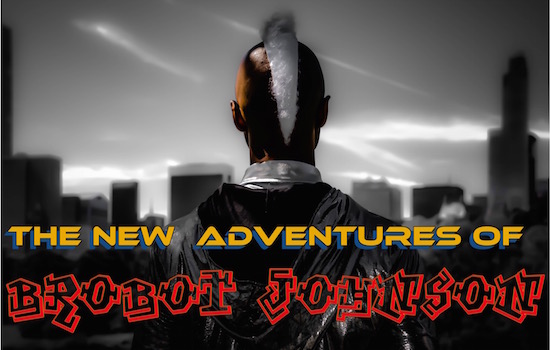
The “classic album,” the coherent long-form work of art, is something you see a lot of nostalgia for, in arguments on…the internet, which is said by the same arguers to have parceled our appreciation and attention-span into tiny flashes of time — the brief cat video, the single song. Then again, people used to collect vinyl 45s in the hundreds, and we’ll still all stare at a series of cute-animal clips for hours at a time. To enjoy any work of art is to intersect with a much broader body of work, and the body is central to the newest canon from poet/rapper Darian Dauchan. The transmedia cycle Brobot Johnson revolves around Dauchan as simultaneous writer, director, composer and star, and around the title character, a human simulation learning the handbook of life. In the tradition of all the best bards, the story (across audio album, web series and upcoming stage show) can be absorbed at epic scope or enjoyed in any of its crystalized components.
The series (The New Adventures of Brobot Johnson) debuts at BrobotJohnson.com on September 23, after a launch at Manhattan’s Nuyorican Poets Cafe on 9/21; the album (Brobot Johnson: Bionic Boom Bap) launches that day on iTunes and CD Baby; and the stage production (The Brobot Johnson Experience) is forthcoming from the All for One Theater company with director Andrew Scoville.
Dauchan plays a dual role in the cleverly lo-tech, high-concept transistor-core videos, as both Brobot and his creator Professor Toussaint, drawing on vintage visual pratfalls and sophisticated emotional observation as the scientist’s shut-in zeal and the bot’s social baby-steps make us smile at our solitary folly and shed tears for our shared fragility. These works reveal the full human code… or at least catch us up on a never-ending story. I spoke with Dauchan by video-link to examine the machinery of this brand-new soul….
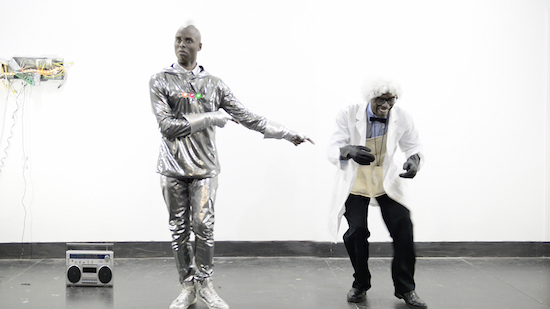
HILOBROW: When you were conceiving the songs, were you also picturing the scenarios of the videos, or did each part suggest the other?
DAUCHAN: It definitely all started with the music. I work with a band, The Mighty Third Rail — a great bass player, Ian Baggette, and a great violinist, Curtis Stewart — but I wanted to do my own solo work, so I started messing around with Ableton Live, creating my own beats. Now with hip-hop, you’re usually sampling something, you’re taking a soul classic and remixing it — but [laughs] I didn’t wanna get sued for anything, I didn’t want to have to buy any samples, so what I ended up creating was just a lot of these digital sounds with the sampling that was already accessed in Ableton Live. Once I started creating these beats, I thought, this has a kind of robotic vibe to it, and me being a storyteller, I started to envision a way… initially I thought I’m just gonna create an instrumental album, but then as I did more of it, I wanted to combine all my loves, of science fiction and cinema, and also being a hip-hop theater artist — was there a way for me to use this music in all of those different kinds of mediums.
And so slowly but surely the Brobot story began to unfold. Then I started thinking about, “what are the lessons this Bro is gonna learn each time,” and so once I established that, and the vibe for each one, some of the songs kind of fell into place. And then the lyrics came. I wanted to write lyrics that were about the topic, but didn’t have to be so on-the-money about each one; not in the traditional sense of a musical where every song is through the perspective of Brobot; I’m more the narrator, I’m speaking on the theme in a larger sense, so I don’t feel as restricted. In Death Boogie [The Mighty Third Rail’s dystopian concept-saga from 2011], each song couldn’t be played out of context, since you’d need to know the overall story. I wanted to create an album where you could listen to any of the songs and have it be its own kind of thing. That was the challenge — create something that could be isolated enough but still connected.
HILOBROW: The song “Jubilee” had great emotional substance for me, even without knowing the storyline of the episode that features it — the project’s different layers have, like, surprises for each other.
DAUCHAN: And personally, that’s just an ode to my big sister, so it’s great that it has those layers to it.
HILOBROW: I was thinking that, in some ways, Brobot is a lot less sci-fi than Death Boogie, and I think the reason is that times change, but people never do. Brobot is about learning our humanity, in the current world, whereas Death Boogie was a dystopian drama. Is some of the best science-fiction really about the present?
DAUCHAN: Knowing that this was gonna be kind of a huge undertaking, I was a bit limited in what I could conceivably do, and didn’t want it to feel like it needed a ton of CGI — it’s supposed to have a bit of a do-it-yourself quality. I wanted it to lean more to a lot of physical-based stuff, that I knew I could do [on my own]. I have a ton of ideas for more seasons, and stories, or even seeing him in other mediums, like animation or comics. So there’s still an opportunity. But this was the origin story, it starts small and gets bigger and bigger as you go.

HILOBROW: Archetypal characters can exist in side-by-side stories that don’t necessarily have to all connect linearly… if you did a Brobot comic, would it retell the story-so-far in that form, or depart into a different narrative?
DAUCHAN: I’d want to pick up where this series ends. If this is about progression, even if it’s not another web series, it would be interesting to start with [REDACTED, since here Darian contemplates a fascinating next step based on the either happy or tragic ending of Season 1 — none of which we’ll give away, but meet us back here after 13 weeks for a sequel commentary!].
For the theatrical production, I’ve been thinking about how am I gonna tell this story, and what’s going to be the concept, the framing for that — because the web series is kind of an origin story, we’ve been playing with the idea of, I’m kind of a “descendant” of Brobot, so when you’re seeing the live concert, perhaps what you are doing is experiencing this other kind of robot learning from his ancestor, so each lesson… it becomes a rite of passage, a legacy to access this information, and the information is these webisodes.
HILOBROW: And it’s like his digital family album… Toussaint is not the old model of the “mad scientist,” he’s not out for conquest, but companionship it seems.
DAUCHAN: I worked with a movement consultant, one of my former teachers Joanne Edelmann at the Stella Adler Studio, and she said, “you’re not sure of Toussaint’s motives for the first few episodes, is it more parental or creating a weapon” — I like that that is left open-ended a bit.
HILOBROW: It even fits with my conception of parenting that when Toussaint is teaching Brobot to fight, he gets punched in the nose but then flashes a thumbs-up — parents want you to surpass them, even if it hurts.
DAUCHAN: That episode also shows that Brobot has some choice. He’s not totally programmed. I want viewers to wonder what’s gonna happen next — when is Brobot in control, and when is he not in control?
HILOBROW: I liked that moment in the “Brobot Fight” episode where he’s about to vanquish his foe [“The Goon”], but he draws not just on his adrenaline mode but on memory files of how it felt when he was punched — in a way typical humans don’t always step back to think about.
DAUCHAN: The actor who plays The Goon, Eddy Rivera, said, “he’s got a post-traumatic mode” — he has his first serious memory recall, because that was such an intense experience, and what do these flashbacks mean for him?
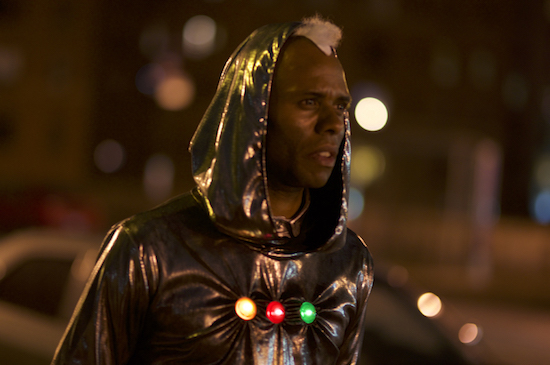
HILOBROW: In the state-of-the-art form of webisodes, you harken back to the roots of media, as with the silent-movie title cards… every time we take a leap forward we seem to loop back around to the basics — which I guess is what happens every time we meet a new person, start a new job, etc., not unlike Brobot. Is there really such a thing as The Future?
DAUCHAN: I went back and looked at a lot of silent films, particularly Charlie Chaplin and Buster Keaton, and you watch that stuff and all of it still really holds up in regard to human behavior, and being incredibly funny, so there’s something very universal and classic about that that never gets old. It also really crosses generations; a young person and an older person could each watch it… that’s another thing, I was talking with my DP, Marcus Middleton, about which version of the album should I use for the web series, ‘cuz I created an explicit and a clean version. As an artist, I didn’t want to censor myself, but as I got more accustomed to the clean version, I thought, this works fine, and this will allow my nephew and niece to watch it, everybody will be able to watch it, and because the themes [themselves] are PG-related, it has an opportunity to reach more folks than I had necessarily envisioned initially.
Also, what’s great about having the songs is, it forces me to create something that can only be five minutes [laugh] — I have to tighten the videos up. It’s a click away, and it’s five minutes — I’ve been watching the episodes on the phone a lot, and it feels like it leans more toward that. I always thought that musicians eventually creating videos for each one of their songs would be the norm.
HILOBROW: Is the clean version the SoundCloud one I’ve heard?
DAUCHAN: There are three versions of the album; the explicit, the clean, and an instrumental one, which kind of goes back to my original intention — ‘cuz I feel really good about these beats, you could totally, like, play this behind a car commercial [laughs]. I wanted to have the opportunity for it to be accessed in a lot of different ways. A lot of times I listen to instrumental stuff when I’m just trying to get work done, so I love being able to give people an option for the way they want to experience the project.

HILOBROW: And you said it was the music that first even suggested other things for you to do with it.
DAUCHAN: For this album I felt I had to step up — “you’re really gonna have to rap on each one of these songs.” [laughs] When I first started with the band, we were doing a lot of poetry and music, and I slowly realized, the more I got immersed in the music, and started to really consider myself a musician, that the rhyming would always sound better than when it was, “hey I’m doing a poem while this music is playing underneath me, just information-information-information,” as opposed to lyrically riding out the beat. It’s been a nice evolution into this.
HILOBROW: One reason I wondered if I was hearing the “clean” version was, there are a few places where I thought it was really hilarious and fitting that some words would be blocked out, but with cheesy mechanical noises, as if, in a cyber-vérité sense, the audio itself comes with its malfunctions pre-loaded. [laughs]
DAUCHAN: That is the clean version! I’d listened to a few clean versions like that, which sounded much better than just muting words, so I played around with that. I’m okay with it because of that malfunctioning quality — and I’m not really swearing that much on the original version.
HILOBROW: To me it was also like a symbol of Brobot already self-editing, though he was literally born yesterday.
DAUCHAN: It’s interesting to think about, “what is the hip-hop”; and I think it’s somehow the fuel that is driving him, like if you had to put gas in him, it would be this. We hint at that when Toussaint puts the headphones onto Brobot and he starts to move again. Like if you were Popeye, hip-hop would be the spinach.
HILOBROW: One of the layers between the three versions that was interesting to me was that we are aware of the Professor as a presence in the videos much more than in the songs. So it’s interesting to think about the layers of, who’s telling what story. So I’m intrigued to see how you’ll work out the stage version, since once again there’s this third, removed figure…
DAUCHAN: We have a workshop in October, which is when we’ll start to play around with whatever that means. We don’t know, but I’m excited about that. I do like that it has an ambiguity. There’s a lot of questions about, who is the MC or the narrator in this, where does that person fit within the story?
HILOBROW: I’m trying to remember who had the idea about there being a third entity that coalesces between artistic collaborators, or even between words and music, or images… and speaking of robots it makes me think of the original 1970s Deathlok comic, where they would have his human voiceover, the computer in his head’s narration, and, briefly, a third, stream-of-consciousness voice…
DAUCHAN: I love that you said that, ’cuz obviously I think things work really dope in threes anyway, so I’m thinking about, wow, it’s like, “the Father, the Son, and what, the MC?” [laughs] I may mention that to Andrew, maybe there is some degree of trinity happening here.
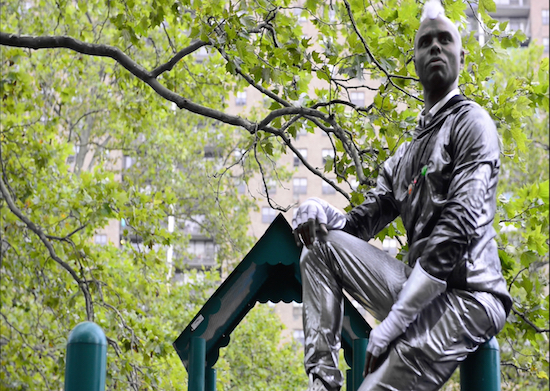
HILOBROW: Is there anything we haven’t covered?
DAUCHAN: What I end up doing definitely could not have been possible, on this level, without the All for One Theater company (Producing Director, Nicholas Cotz; Artistic Director, Michael Wolk) co-producing. They really stepped up, and got me a person to create the set; a prop master (Casey Alexander Smith); they got me production assistants (Heather Konish and Itohan Edoloyi) — the level on which you’re watching everything was elevated; to have that support and backing has brought it to a whole new level, to make what I envision a reality.
Also, the three sources that really shaped Brobot were, if Edward Scissorhands, Johnny Five and Brother from Another Planet had a baby it would be Brobot Johnson, so those are the three that really influenced my way of figuring out how I was gonna shape the story and the concept.
HILOBROW: I love the range of references — from your novelty-toy dunking-bird dance in one ep, to script directions for the camera to “circle like in Saturday Night Fever“, etc. — like a visual remix to match the music.
DAUCHAN: There’s so many homages in there! I had to explain to my DP that the holding-up-the-boombox scene was from Say Anything [laughs]; there’s a lot of remixing, if you catch it, then you’ll catch it.
HILOBROW: I love the omni-directional knowledge-bank…how the lyrics will go from Facts of Life references to Fiddler on the Roof…
DAUCHAN: I was talking again to my movement consultant, and it was like, a lot of it is a conglomerate — if you type in something, what would you find on the internet; if it’s all programming, then yes, it’s gonna [compile] some weird funkiness of clichés an’ shit. So if you think about Toussaint crafting Brobot and programming things into him, a lot of what is out there is gonna come in.
HILOBROW: Speaking of All for One helping you go up in budget, I was surprised by how high-end the finished footage looked, since I thought it would be hilarious enough just from the “mock” episode you had put up…
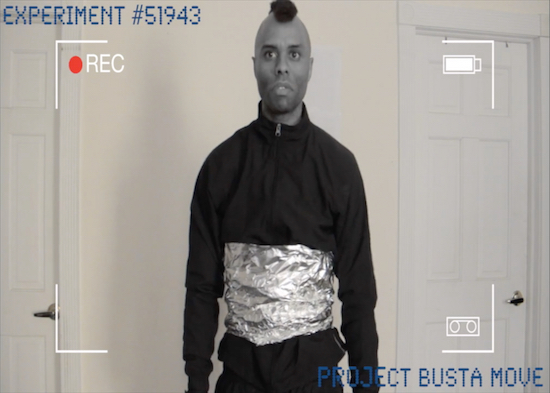
DAUCHAN: There was definitely a point when we asked [ourselves], how sophisticated do you want this to be, what is the aesthetic you want for this, and I had always leaned toward, I want it to be doable, it doesn’t have to be perfect. There is a degree of humor to that. My agent had seen that mock episode too, and she said, “Oh, I miss all the tinfoil Brobot was wearing” [laughs] — I’ve gotten a lot of compliments from just the mock episode; that let me feel that I was on the right track. So much of it is about sequencing, and just riding out the energy of the music, and that to me is the core of the whole web series, it really is about the music; the music is what fuels the whole thing.
HILOBROW: The tinfoil to me harkened to the rest of UFO/conspiracy culture — even though Brobot didn’t wear it on his head.
DAUCHAN: You’ll see a little bit of that! We had to block out the windows, ‘cuz we needed to be able to shoot at any hour of the day. So we said, “well what do we want to have up there, do we just wanna have black curtains?” I was like, “nah, you should add some of that tinfoil” [laughs], if this is Toussaint’s place maybe he does believe some of that stuff!
[At this point DD had to return to the editing lab to finish bringing the rest of his creation to life, but the evolution is soon to be streamed, at http://www.brobotjohnson.com/ ]
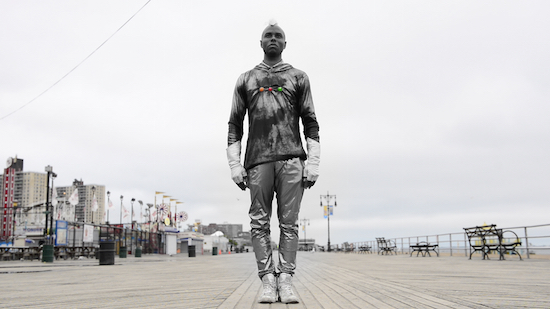
Photos/stills: Marcus Middleton
MORE POSTS by ADAM McGOVERN: OFF-TOPIC (2019–2025 monthly) | textshow (2018 quarterly) | PANEL ZERO (comics-related Q&As, 2018 monthly) | THIS: (2016–2017 weekly) | PEOPLE YOU MEET IN HELL, a 5-part series about characters in McGovern’s and Paolo Leandri’s comic Nightworld | Two IDORU JONES comics by McGovern and Paolo Leandri | BOWIEOLOGY: Celebrating 50 years of Bowie | ODD ABSURDUM: How Felix invented the 21st century self | CROM YOUR ENTHUSIASM: C.L. Moore’s JIREL OF JOIRY stories | KERN YOUR ENTHUSIASM: Data 70 | HERC YOUR ENTHUSIASM: “Freedom” | KIRK YOUR ENTHUSIASM: Captain Camelot | KIRB YOUR ENTHUSIASM: Full Fathom Five | A 5-part series on Jack Kirby’s Fourth World mythos | Reviews of Annie Nocenti’s comics Katana, Catwoman, Klarion, and Green Arrow | The curated series FANCHILD | To see all of Adam’s posts, including HiLo Hero items on Lilli Carré, Judy Garland, Wally Wood, and others: CLICK HERE
